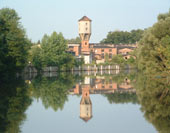The lock at the Wolfwinkel
Our walk leads us to the lock at the Wolfwinkel (3). When in 1740 the eager Frederick II (the Great) took over Prussian’s state affairs, waterway building received a new impulse. After his decision to build the Finow Canal, he pushed the project forward. A royal commission took its seat in Neustadt – Eberswalde to observe the progress in work.
For building the second Finow Canal the older course was used and supposed to get straightened. At Niederfinow they built three kilometres completely anew. Parts of the old sluices could be integrated into the new ones. At the Wolfswinkel lock they could even use the complete ground. Frederick II even commanded soldiers from prince Heinrich, Münchow and Bredow to be deployed to the construction site in order to move on. In 1746 the second Finow Canal was completed. Frederick underlined the importance of this waterway and its sluices by personally signing the "INSTRUCTION for the sluice masters at Finow Canal" in 1747. Now convoys of ships moved through the canal day by day.
Wood rafters also used the artificial waterway.
During the travel they were living on their logs. At night they put up tents. For preparing a warm meal they lit up an open fire on the raft. Work was dangerous, the floating baggage became longer and longer. Some rafts had to be untied before passing a lock. Barges and rafts were hauled through the canal. That means that men or animals pulled them. The paths along the banks were built for that purpose. When the wind was good, a sail supported the journey.


